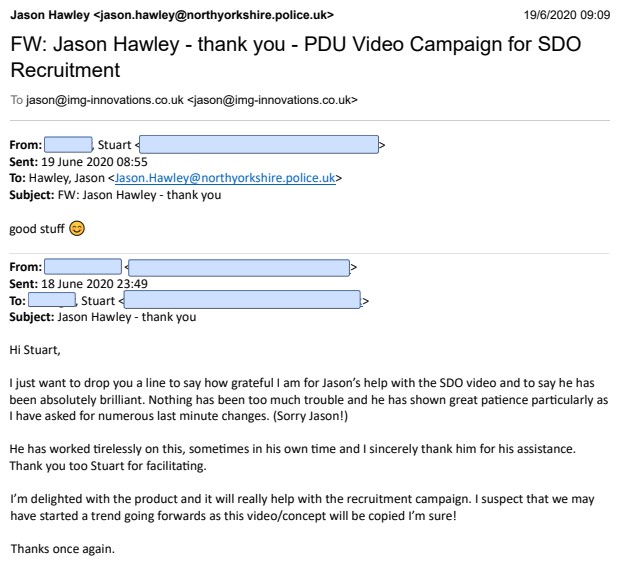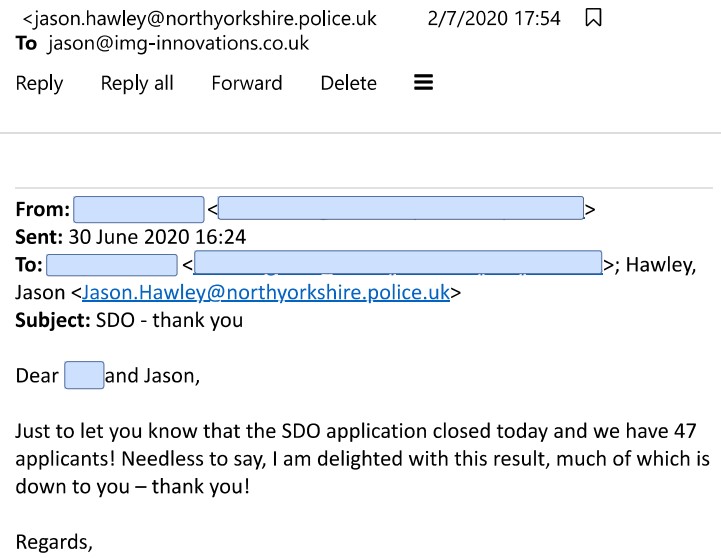Sometimes, it can often be best to demonstrate the sort of work we have been involved with which demonstrates some of our experience and how we have dealt with given situations. Below are examples of real life experiences and how we addressed the issues:
Case Scenario 1
Situation
North Yorkshire Police use their excellent service desk team to answer all IT questions as part of the support mechanism. It was becoming more prevalent that many service desk requests were involving issues that could be addressed via a self-service process which would reduce the existing pressures to the team and give the support analysts the opportunity to focus on the more complex issues being raised.
In addition, this was one of several other project requirements from a training prospective, within the workflow.
Objectives
As part of the Training and Learning Development requirements, we were tasked to:
- Assess historical calls
- Evaluate how we could streamline the number of calls answered by the service desk.
- Propose and implement what options could be available to address the issues.
- Create bite sized video training tutorials to answer regular request questions that the help/service desk receive on a regular basis, directly, via telephone from users and then facilitate the need for the video tutorials to be accessible for all users.
Actions Taken:
- To investigate service desk stats and establish what were the most commonly featured questions requested.
- To define which departments these questions were applicable to.
- To speak and collaborate with each department managers to concur the objectives to be achieved in relation to the findings.
- To create bite sized video tutorials for those questions and verify that work produced was satisfactory to requirements.
- Add supporting PDF documentation for each of the bite-sized training video tutorials.
- Create a central knowledge base on the force’s Intranet.
- To upload the PDF’s and tutorials to the Intranet
- Provide means comms for notification, access and usage on all platforms such as desktop, laptop, table and mobile phone.
Results
- Despite minimal data being made available and workload being shared across 4 other projects as detailed above, we completed the creation of 117 of 129 PDF help guides and video tutorials using Camtasia which equated to producing 90.7% of the work requirements.
- As a result of the work we were producing, it quickly got round to other departments who wanted to use our services to help them produce work for them. Several other projects were recommended for us to assist them including:
- Incident reporting – Using Microsoft Teams with the public to conduct interviews regarding incidents and producing bite sized video tutorials to provide instruction, particularly as a means to service the public whilst the influence of COVID was strongly upon us. This managed to attain a resource saving in police response times in excess of 55%.
- Resolved 2 systems that influenced a more cost and resource effective communications for public interviews involving court attendance.
- Introduced a ‘New Training Starter Pack’ for new civilian and Police staff.
- A recruitment campaign for Student Development Officers proved very successful by developing and completing a video marketing recruitment campaign which delivered responses exceeding 114% of target. (A senior officer recommendation and redacted copy of the campaign video is available to view below).
- For HR, we produced user tutorials to deal with how senior officers deal with disciplinary procedures.
- TuServe software – Creation of several bite sized training tutorials relevant to some modules.
- Reviewing options to assist in producing tutorials for the Niche software.
- Two of the extra work areas, unknowingly, produced complimentary emails (Copies available) sent to line management from senior police staff referring to the standard of work, the results it delivered and how our suggestions and recommendations helped to influence how the finished product was completed.


Case Scenario 2
Situation
Rotherham General Hospital NHS Trust was undertaking a large £42m transition program with the implementation of a new patient management software system called Meditech and part of the support for this was to implement a hardware roll out of 2500 items of IT kit across the hospital campus which represented a £1.8m share of the overall project budget.
As a result of a medical emergency, there was a requirement to replace the project manager responsible for the implementation of the hardware rollout and that work came to us at IMG Innovations Ltd.
When the time came to rollout the label printers for the 96 ward cubicle rooms, we discovered:
- The wrong printers had been ordered by procurement which required an additional socket for the wireless transmitter to work instead of the one’s ordered which had this facility built into the unit.
- The delivery of these units arrived the day before implementation.
- Additional sockets were needed for other aspects of the IT kit implementation.
Objectives
- Additional sockets needed to be installed into each room by external contractors.
- To work around the flow of patients in and out of these rooms which had a 3-hour window to complete each unit.
- To install and test the printers.
- To minimise cost and reduce risk of project creep.
- The work had to be completed ASAP due to other influences and dependencies that this work was paramount for.
Actions Taken:
- I contacted my manager and arranged a 1:2:1 and explained the circumstances which would potentially cause some delay in the project. We discussed how we could resolve the issue and revised timelines/deadlines for completion considering as many factors as possible that risk influencing the timeline.
- I lead discussions with the bed management department to arrange how we could manage the workflow between the patient crossover to allow the inhouse tech team to install and test the kit.
- We managed to get splitter cables fitted for the label printers which facilitated power to both the printer and the Wi-Fi transmitter. This reduced the need for new sockets to be fitted by external contractors and thus reduce additional costs which would add to the overall budget.
- Whilst collaborating with the bed management team and my support officer, we coordinated the internal technical staff, in synchronisation, to install new sockets, IT equipment and test it all for operational readiness.
- We deployed 3 teams of 2 technical staff personnel to install and test the equipment at given locations when the locations became available to get the work completed.
- Monitored workflow activity for each team throughout the process and triaged workload accordingly as to resource speed of completion and as such, provide feedback availability when rooms were completed.
- Reviewed each process as an ongoing activity to achieve completion for timelines.
Results
- The project deadlines were re-organised and with reduced implementation time to set up, had very little effect on project completion.
- With much communication and excellent co-ordination, we did everything without bear minimal delay or interruption to patient care.
Case Scenario 3
Situation
As part of a £30m cost saving program across 7 NHS trusts in the East Midlands region, the implementation of a Change Management data system for recording and reporting on all Change Management activities was required which would be centralised and hold all the patient notes and imagery from the Radiology and associated departments into one central data resource in order to streamline the speed for patient care, for treating patients involving Xray, CT scans, MRI scans etc. and to reduce costs.
Objectives
To set up and manage the change management process for the organisation. These were broken down into tasks which involved:
- To initially investigate and review the current Change Management Model.
- The processes involved for raising and actioning change requests.
- The monitoring of all change request activities.
- Determining the communication requirements with all stakeholder parties involved.
Actions Taken:
- I investigated all current activities using Gap analysis process models.
- Created Standard Operating Procedures (SOP’s) to crystalise work functions.
- Review and action the requirements needed to be included upon the request for change document.
- Created and extensive excel spreadsheet which recorded and monitored all change activities.
- Used a central contact list to detail all stakeholder managers from all the 7 NHS trusts.
- Maintain continued active communications with all stakeholder parties involved.
- Organised and chaired a weekly Change Advisory Board meeting (CAB) to address each change request involving all stakeholders or their assistants in their absence.
- Provide weekly (sometimes daily) updates and management information on all event activity across the consortium.
Results
- Established a set of functional activities and procedures to follow for change requirement.
- Provided one central document which recorded all activity for change.
- Continually kept all stakeholders involved in activities.
- Maintained communications across the consortium.
- To maintain continued active communications with all stakeholder parties involved via Microsoft Teams, email and telephone.
Resulted in providing key management data for performance analysis against project objectives and milestones and improved productivity by 80%.